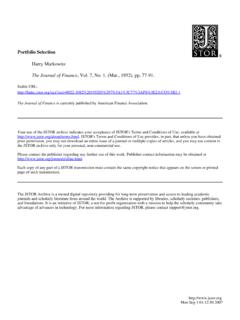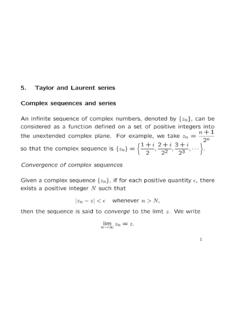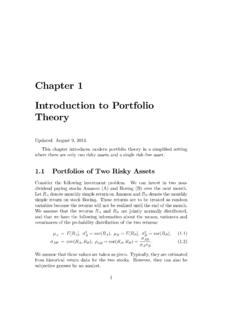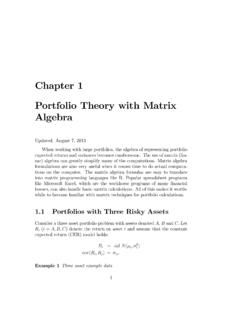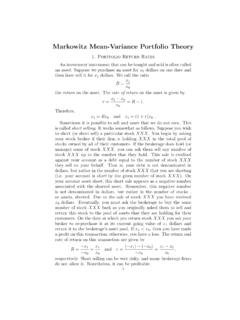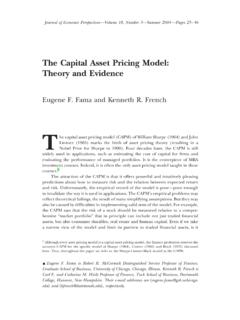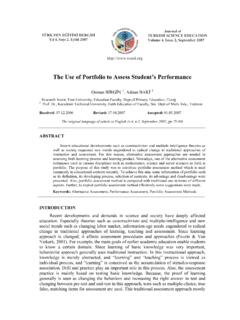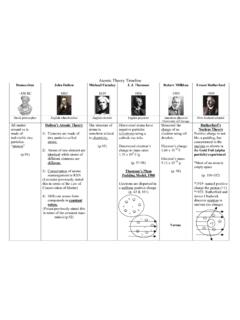Transcription of (2.1) Markowitz’s mean-variance formulation (2.2) Two …
1 2. mean-variance portfolio theory( ) markowitz s mean-variance formulation ( ) Two-fund theorem( ) Inclusion of the riskfree markowitz mean-variance formulationSuppose there areNrisky assets, whose rates of returns are given by the randomvariablesR1, , RN, whereRn=Sn(1) Sn(0)Sn(0), n= 1,2, , (w1 wN)T, wndenotes the proportion of wealth invested in assetn,withNXn=1wn= 1. The rate of return of the portfolio isRP=NXn= There does not exist any asset that is a combination of other assets in theportfolio, that is, non-existence of redundant = (R1R2 RN) and1= (1 1 1) are linearly independent, otherwiseRPis a constant irrespective of any choice of portfolio first two moments ofRPare P=E[RP] =NXn=1E[wnRn] =NXn=1wn n,where n=Rn,and 2P= var(RP) =NXi=1 NXj=1wiwjcov(Ri, Rj) =NXi=1 NXj=1wi denote the covariance matrix so that 2P=wT example whenn= 2, we have(w1w2) 11 12 21 22!
2 W1w2!=w21 21+w1w2( 12+ 21) +w22 The portfolio risk of return is quantified by 2P. In mean-varianceanalysis, only the first two moments are considered in the port-folio model. Investment theory prior to markowitz consideredthe maximization of Pbut without The measure of risk by variance would place equal weight onthe upside deviations and downside In the mean-variance model, it is assumed that i, iand ijareall portfolioConsider two risky assets with known meansR1andR2, variances 21and 22, of the expected rates of returnsR1andR2, togetherwith the correlation coefficient .Let 1 and be the weights of assets 1 and 2 in this mean:RP= (1 )R1+ R2,0 1 portfolio variance : 2P= (1 )2 21+ 2 (1 ) 1 2+ 2 represent the two assets in a mean-standard deviation diagram(recall: standard deviation = variance )As varies, ( P,RP) traces out a conic curve in the = 1, it is possible to have = 0 for some suitable choice ofweight.
3 In general, putting two assets whose returns are negativelycorrelated has the desirable effect of lowering the portfolio particular, when = 1, P( ; = 1) =q(1 )2 21+ 2 (1 ) 1 2+ 2 22= (1 ) 1+ is the straight line joiningP1( 1,R1) andP2( 2,R2).When = 1, we have P( ; = 1) =q[(1 ) 1 2]2=|(1 ) 1 2|.When is small (close to zero), the corresponding point is close toP1( 1,R1). The lineAP1corresponds to P( ; = 1) = (1 ) 1 pointA(with zero ) corresponds to = 1 1+ quantity (1 ) 1 2remains positive until = 1 1+ > 1 1+ 2, the locus traces out the upper 1< <1, the minimum variance point on the curve thatrepresents various portfolio combinations is determined by 2P = 2(1 ) 21+ 2 22+ 2(1 2 ) 1 2= 0 setgiving = 21 1 2 21 2 1 2+ formulation of markowitz s mean-variance analysisminimize12 NXi=1 NXj=1wiwj ijsubject toNXi=1wiRi= PandNXi=1wi= 1.
4 Given the target expectedrate of return of portfolio P, find the portfolio strategy that mini-mizes form the LagrangianL=12 NXi=1 NXj=1wiwj ij 1 NXi=1wi 1 2 NXi=1wiRi P where 1and 2are Lagrangian then differentiateLwith respect towiand the Lagrangian mul-tipliers, and set the derivative to zero. L wi=NXj=1 ijwj 1 2Ri= 0, i= 1,2, , N.(1) L 1=NXi=1wi 1 = 0;(2) L 2=NXi=1wiRi P= 0.(3)From Eq. (1), the portfolio weight admits solution of the formw = 1( 11+ 2 )(4)where1= (1 1 1)Tand = (R1R2 RN) determine 1and 2, we apply the two constraints1 =1T 1 w = 11T 11+ 21T 1 .(5) P= T 1 w = 1 T 11+ 2 T 1 .(6)Writea=1T 11, b=1T 1 andc= T 1 , we have1 = 1a+ 2band P= 1b+ for 1and 2: 1=c b P and 2=a P b , where =ac that 1and 2have dependence on P, which is the targetmean prescribed in the variance minimization 6=h1, and 1exists.
5 Since is positive definite, soa >0, c >0. By virtue of the Cauchy-Schwarz inequality, > minimum portfolio variance for a given value of Pis given by 2P=w T w =w T ( 1 11+ 2 1 )= 1+ 2 P=a 2P 2b P+c .The set of minimum variance portfolios is represented by a paraboliccurve in the 2P Pplane. The parabolic curve is generated byvarying the value of the parameter , when Pis plotted against P, the set of minimumvariance portfolio is a hyperbolic are the asymptotic values of lim d Pd P?d Pd P=d Pd 2Pd 2Pd P= 2a P 2b2 P= a P bqa 2P 2b P+cso thatlim d Pd P= s P, we obtain 1=c b P and 2=a P b , and the optimalweightw = 1( 11+ 2 ).
6 To find the global minimum variance portfolio , we setd 2Pd P=2a P 2b = 0so that P=b/aand 2P= 1/a. Correspondingly, 1= 1/aand 2= 0. The weight vector that gives the global minimum varianceis found to bewg= 11a= 111T portfolio that corresponds to 1= 0 is obtained when Pis taken to becb. The value of the other Lagrangian multiplier isgiven by 2=a cb b = weight vector of this particular portfolio isw d= 1 b= 1 1T 1 .Also, 2d=a cb 2 2b cb +c = setGivenNrisky assets, we form various portfolios from plot the point ( P,RP) representing the portfolios in the Rdiagram. The collection of these points constitutes the feasible setor feasible a 3-asset portfolio , the various combinations of assets 2and 3 sweep out a curve between them (the particular curve takendepends on the correlation coefficient 12).
7 A combination of assets 2 and 3 (labelled 4) can be combined withasset 1 to form a curve joining 1 and 4. As 4 moves between 2 and3, the curve joining 1 and 4 traces out a solid of feasible regions1. If there are at least 3 risky assets (not perfectly correlatedand with different means), then the feasible set is a solid two-dimensional The feasible region isconvex to the left. That is, given any twopoints in the region, the straight line connecting them doesnotcross the left boundary of the feasible region. This is because theminimum variance curve in the mean-variance plot is a variance set and efficient fundsThe left boundary of a feasible region is called theminimum varianceset.
8 The most left point on the minimum variance set is called theminimum variance point. The portfolios in the minimum varianceset are calledfrontier a given level of risk, only those portfolios on theupper halfof the efficient frontier are desired by investors. They are calledefficient portfoliow is said to be mean-variance efficient if there existsno portfoliowwith P Pand 2P 2P, except itself. That is,you cannot find a portfolio that has a higher return and lower riskthan those for an efficient Two-fund theoremTwo frontier funds (portfolios) can be established so that any fron-tier portfolio can be duplicated, in terms of mean and variance , asa combination of these two.
9 In other words, all investors seekingfrontier portfolios need only invest in combinations of these convex combination (that is, weights are non-negative)of ef-ficient portfolios is an efficient portfolio . Let i 0 be the weightof Fundiwhose rate of return isRif. SinceEhRifi bafor alli, wehavenXi=1 iEhRifi nXi=1 iba= (w11 w1n), 11, 12andw2= (w21 w2n)T, 21, 22are twoknown solutions to the minimum variance formulation with expectedrates of return 1 Pand 2P, ijwj 1 2Ri= 0, i= 1,2, , n(1)nXi=1wiri= P(2)nXi=1wi= 1.(3)It suffices to show that w1+ (1 )w2is a solution correspondsto the expected rate of return 1P+ (1 ) w1+(1 )w2is a legitimate portfolio with weights that sumto Eq.
10 (1) is satisfied by w1+ (1 )w2since the system ofequations is Note thatnXi=1h w1i+ (1 )w2iiRi= nXi=1w1iRi+ (1 )nXi=1w2iRi= 1P+ (1 ) minimum variance portfolio with target mean Pcan be uniquelydecomposed into the sum of two portfoliosw P=Awg+ (1 A)wdwhereA=c b P a minimum- variance portfolio whose solution of the Lagrangianmultipliers are 1and 2, the optimal weight isw P= 1 11+ 2 1 = 1(awg) + 2(bwd).Observe that the sum of weights is 1a+ 2b=ac Pb +b Pa b =ac b2 = set 1a=Aand 2b= 1 A, where 1=c Pb and 2= Pa b .24 Indeed, any two minimum- variance portfolios can be used to substi-tute forwgandwd. Supposewu= (1 u)wg+uwdwv= (1 v)wg+vwdwe then solve forwgandwdin terms ofwuandwv.
